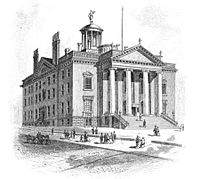47th New York State Legislature
| 47th New York State Legislature | |||||||
|---|---|---|---|---|---|---|---|
|
|||||||

The Old State Capitol (1879)
|
|||||||
| Overview | |||||||
| Jurisdiction | New York, United States | ||||||
| Term | January 1 – December 31, 1824 | ||||||
| Senate | |||||||
| Members | 32 | ||||||
| President | Lt. Gov. Erastus Root (Buckt.) | ||||||
| Party control | Bucktail (17-14) | ||||||
| Assembly | |||||||
| Members | 128 | ||||||
| Speaker | Richard Goodell (Buckt.) | ||||||
| Party control | Bucktail | ||||||
| Sessions | |||||||
|
|||||||
| 1st | January 7 – April 12, 1824 |
|---|---|
| 2nd | August 2 – 6, 1824 |
| 3rd | November 2 – 27, 1824 |
The 47th New York State Legislature, consisting of the New York State Senate and the New York State Assembly, met from January 6 to November 27, 1824, during the second year of Joseph C. Yates's governorship, in Albany.
Under the provisions of the New York Constitution of 1821, 32 Senators were elected on general tickets in eight senatorial districts for four-year terms. They were divided into four classes, and every year eight Senate seats came up for election. Assemblymen were elected countywide on general tickets to a one-year term, the whole Assembly being renewed annually.
Jacob Sutherland declined to take his seat in the State Senate at the beginning of the previous session, leaving a vacancy in the Third District. State Senator Joseph Spencer died on May 2, 1823, leaving a vacancy in the Eighth District.
The previous session had been dominated by the Bucktails faction of the Democratic-Republican Party. The opposing Democratic-Republican faction, the "Clintonians" had almost disappeared after DeWitt Clinton decided not to run in the New York gubernatorial election, 1822. In 1823, a major controversy arose concerning the presidential succession. Martin Van Buren supported William H. Crawford and was sure to get New York's presidential votes by electing a Bucktail majority to the Legislature which at this time elected the presidential electors. This scheme was opposed not only by the Clintonians, but also by a very large part of the Bucktails, and led to a breakdown of party lines. The Anti-Crawford factions, favoring at this time John Quincy Adams, Henry Clay, Andrew Jackson and John C. Calhoun as possible presidential candidates, proposed to have the presidential electors elected by the people in districts, similar to the congressional elections, and became known as the "People's Party". The rump Bucktail faction (which followed Van Buren) was called the "Regency Party" by their opponents, a reference to the Albany Regency.
...
Wikipedia
